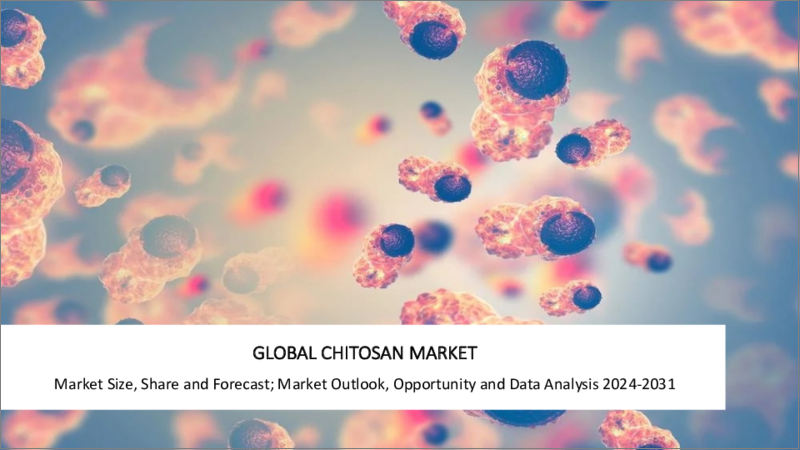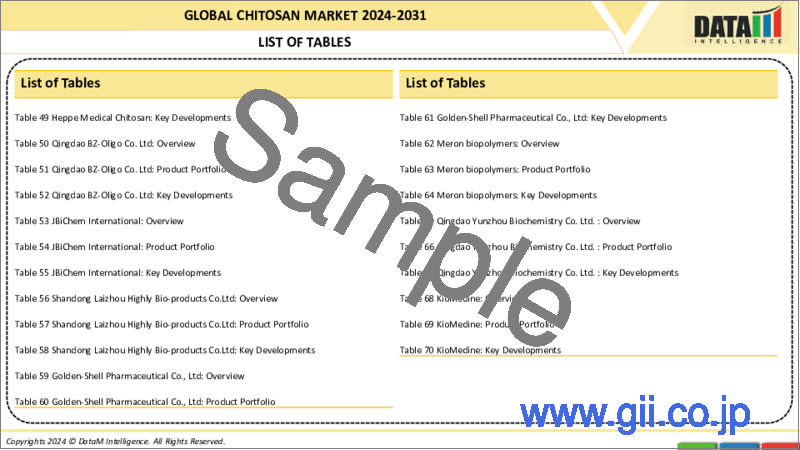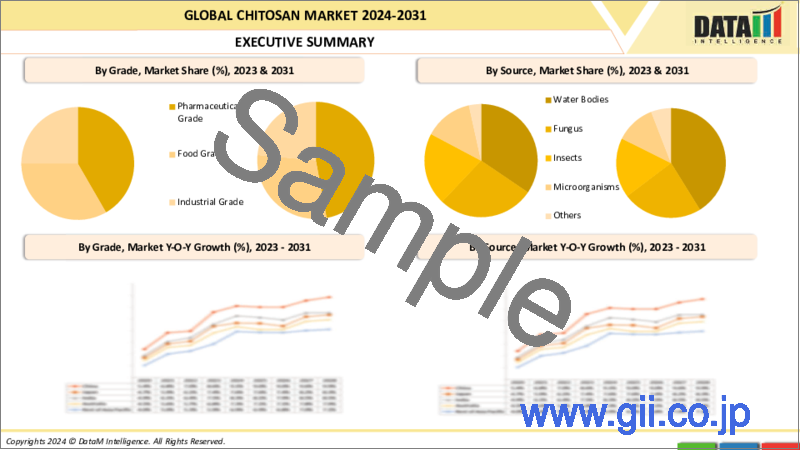|
|
市場調査レポート
商品コード
1297770
キトサンの世界市場-2023年~2030年Global Chitosan Market - 2023-2030 |
||||||
カスタマイズ可能
適宜更新あり
|
|||||||
| キトサンの世界市場-2023年~2030年 |
|
出版日: 2023年06月15日
発行: DataM Intelligence
ページ情報: 英文 195 Pages
納期: 即日から翌営業日
|
- 全表示
- 概要
- 目次
市場概要
キトサンの世界市場は2022年に98億米ドルに達し、2030年には293億米ドルに達するなど、有利な成長が予測されています。キトサンの世界市場は、2023年から2030年の予測期間中に15.2%のCAGRを示すと予測されています。
3Dプリンティング用途でのキトサン利用の増加が、キトサン市場動向の需要を牽引しています
キトサン市場は、その多様な用途と持続可能性により、独自の成長機会を目の当たりにしています。水質汚染に対する意識の高まりと効率的な水処理ソリューションの必要性が、市場の成長をさらに後押ししています。
さらに、生物活性キトサン誘導体の進歩により、生物医学や組織工学分野での機能強化や応用が可能になりつつあります。しかし、生産コストの高騰やサプライチェーンの混乱といった課題があるため、市場の持続的成長のためには、継続的な技術革新とコスト最適化戦略が必要です。
キトサンの世界市場は、環境に優しく持続可能な製品に対する需要の高まり、幅広い用途、ヘルスケアと医薬品への注目の高まり、水処理に対する意識の高まり、化粧品業界からの需要の増加、技術の進歩によって牽引されています。
市場力学
環境に優しく持続可能な製品に対する需要の高まりがキトサン市場の成長を牽引
キトサンは、エビやカニなどの甲殻類の殻に豊富に含まれるキチンから得られます。水産加工から排出されるキチンを利用することで、廃棄物を削減できるだけでなく、再生可能な資源を利用することができるため、キトサンは環境に優しい選択肢となります。
キトサンの生産は一般的に、合成ポリマーよりもエネルギー消費が少なく、温室効果ガスの排出も少ないです。このような環境フットプリントの削減は、環境意識の高い消費者や企業にアピールします。
抗菌性や皮膜形成能力といったキトサンのユニークな特性は、様々な用途で合成化学薬品に代わる天然の代替品として使用することを可能にします。
例えば、国立医学図書館が2022年4月5日に発表した論文によると、キトサンは食品包装、持続可能な農業、製紙などさまざまな目的に使用できるユニークな素材です。
キトサンを持続的に使用するための最も重要な進歩は、循環経済を促進することです。キトサンの合成から様々な用途まで、様々な側面に焦点を当てています。
化粧品業界からの需要増加もキトサン市場の成長を促進
消費者はますます自然で環境に優しい化粧品を求めるようになっています。再生可能な海洋資源に由来し、生分解性を有するキトサンは、このような嗜好に合致しており、自然で持続可能な化粧品に望ましい成分となっています。
キトサンには創傷治癒を促進し、瘢痕形成を抑える作用があるため、創傷、火傷、その他の皮膚疾患の治療を目的としたスキンケア製品に求められる成分です。その再生特性は、組織の修復と若返りを促進します。
キトサンは一般的に皮膚への耐性が高く、アレルギーの可能性も低いため、様々な化粧品製剤に適しています。天然由来で有害な化学物質を含まないため、優しく安全なスキンケア製品を求める消費者にアピールできます。
限られた原料の入手可能性が市場の成長を妨げます
キトサンの生産は、原料ソースとして甲殻類の廃棄物の入手可能性に大きく依存しています。甲殻類の殻の供給は、漁期の変動、規制の変更、甲殻類の個体数の変動などの要因によって制限される可能性があります。
甲殻類の利用可能性は季節変動に影響され、悪天候や海洋生態系の変化などの自然要因は甲殻類の個体数や利用可能性に影響を与え、原料供給の変動につながります。
水産業を取り巻く持続可能性や環境への懸念も、原料の入手性に影響を与える可能性があります。漁獲枠、混獲の削減、持続可能な漁法に関する厳しい規制は、キトサン生産用の甲殻類廃棄物の供給を制限する可能性があります。
COVID-19影響分析
COVID-19の大流行はキトサン市場に大きな影響を与えました。このパンデミックは、封鎖措置、渡航制限、生産活動の縮小により、世界のサプライチェーンに混乱を引き起こしました。このため、キトサン生産用の原材料の調達が困難になり、キトサンをベースとした製品の入手性に影響が出ました。
キトサンベースのイノベーションに関連する研究開発活動は、研究室へのアクセスの制限、資金の減少、パンデミック関連研究へのリソースの振り向けなどにより、遅延または中断した可能性があります。経済がパンデミックから徐々に回復するにつれ、持続可能で環境に優しいソリューション、水処理、ヘルスケアへの注目が高まるため、キトサン市場は再び勢いを取り戻すと予想されます。
ロシア・ウクライナ紛争の影響分析
ロシアとウクライナの紛争は、世界のキトサン市場に中程度の影響を与えると推定されます。紛争は不透明な雰囲気を作り出し、投資家の信頼に悪影響を及ぼす可能性があります。この不確実性はキトサン市場への投資を抑制し、研究開発活動、技術革新、市場全体の成長を低下させる可能性があります。
紛争は、各国間の貿易関係や嗜好を変化させる可能性があります。このため、各国が代替サプライヤーを求めたり、貿易政策を調整したりすることで、需要パターンや市場シェアが変化し、キトサン市場力学が変化する可能性があります。
目次
第1章 調査手法と調査範囲
第2章 定義と概要
第3章 エグゼクティブサマリー
第4章 市場力学
- 影響要因
- 促進要因
- 環境に優しく持続可能な製品に対する需要の高まり
- 化粧品業界からの需要の増加
- 抑制要因
- 高い生産コスト
- 機会
- キトサン法の技術的進歩
- 影響分析
- 促進要因
第5章 産業分析
- ポーターの5フォース分析
- サプライチェーン分析
- 価格分析
- 規制分析
第6章 COVID-19分析
第7章 グレード別
- 医薬品グレード
- 食品グレード
- 工業グレード
第8章 用途別
- 農業用
- 水処理
- 医薬品・医療
- 飲食品
- 化粧品
- その他
第9章 地域別
- 北米
- 米国
- カナダ
- メキシコ
- 欧州
- ドイツ
- 英国
- フランス
- スペイン
- イタリア
- その他欧州
- 南米
- ブラジル
- アルゼンチン
- その他南米
- アジア太平洋
- 中国
- インド
- 日本
- オーストラリア
- その他アジア太平洋地域
- 中東・アフリカ
第10章 競合情勢
- 競合シナリオ
- 市況/シェア分析
- M&A分析
第11章 企業プロファイル
- Sigma Aldrich
- 会社概要
- 製品ポートフォリオと説明
- 財務概要
- 主な発展
- Heppe Medical Chitosan
- Kimica Corporation
- Qingdao BZ-Oligo Co. Ltd
- G.T.C. Bio Corporation
- JBiChem International
- Dungeness Environmental Solutions Inc.
- Shandong Laizhou Highly Bio-products Co.Ltd
- Primex
- Meron biopolymers.
第12章 付録
Market Overview
The Global Chitosan Market reached US$ 9.8 billion in 2022 and is projected to witness lucrative growth by reaching up to US$ 29.3 billion by 2030. The Global Chitosan Market is expected to exhibit a CAGR of 15.2% during the forecast period 2023-2030.
The increasing utilization of chitosan in 3D printing applications drives the demand for chitosan market trends.
The chitosan market is witnessing unique growth opportunities due to its versatile applications and sustainability. The rising awareness about water pollution and the need for efficient water treatment solutions further propel market growth.
Additionally, the market is experiencing advancements in bioactive chitosan derivatives, enabling enhanced functionalities and applications in biomedical and tissue engineering sectors. However, challenges like high production costs and supply chain disruptions necessitate continuous innovation and cost optimization strategies for sustained market growth.
The Global Chitosan Market is driven by growing demand for eco-friendly and sustainable products, a wide range of applications, increasing focus on healthcare and pharmaceuticals, rising awareness about water treatment, increasing demand from the cosmetic industry, and technological advancements.
Market Dynamics
Growing Demand for Eco-Friendly and Sustainable Products Drive the Growth of the Chitosan Market
Chitosan is derived from chitin, abundant in crustaceans' shells such as shrimp and crabs. The use of chitin waste from seafood processing not only reduces waste but also utilizes a renewable resource, making chitosan an eco-friendly choice.
Chitosan production generally involves lower energy consumption and emits fewer greenhouse gases than synthetic polymers. This reduced environmental footprint appeals to environmentally conscious consumers and businesses.
Chitosan's unique properties, such as antimicrobial and film-forming capabilities, allow it to be used as a natural alternative to synthetic chemicals in various applications like it can be used as a natural preservative in the food industry, reducing the need for chemical additives.
For instance, according to an article, by the National Library of Medicine published on April 05, 2022, chitosan is a unique material that can be used for different purposes, such as food packaging, sustainable agriculture, and paper production.
The most important advances for using chitosan sustainably promote a circular economy. It focuses on different aspects of chitosan from its synthesis to multiple applications.
Increasing Demand From the Cosmetic Industry Also Drives the Growth of the Chitosan Market
Consumers are increasingly seeking natural and eco-friendly cosmetic products. Chitosan, derived from renewable marine sources and biodegradable, aligns well with these preferences, making it a desirable ingredient for natural and sustainable cosmetics.
Chitosan's ability to accelerate wound healing and reduce scar formation makes it a sought-after ingredient in skincare products targeting the treatment of wounds, burns, and other skin conditions. Its regenerative properties promote tissue repair and rejuvenation.
Chitosan is generally well-tolerated by the skin and has low allergenic potential, making it suitable for various cosmetic formulations. It's natural origin and absence of harmful chemicals appeal to consumers seeking gentle and safe skincare products.
Limited Raw Material Availability will Hamper the Growth of the Market.
Chitosan production heavily relies on the availability of crustacean waste as a raw material source. The supply of crustacean shells can be limited by factors such as variations in fishing seasons, changes in regulations, and fluctuations in crustacean populations.
Crustacean availability can be affected by seasonal variations and natural factors like adverse weather conditions or changes in oceanic ecosystems can impact the population and availability of crustaceans, leading to fluctuations in raw material supply.
Sustainability and environmental concerns surrounding the fishing industry can also impact the availability of raw materials. Strict regulations related to fishing quotas, bycatch reduction, and sustainable fishing practices can restrict the supply of crustacean waste for chitosan production.
COVID-19 Impact Analysis
The COVID-19 pandemic significantly impacted the chitosan market. The pandemic caused disruptions in global supply chains due to lockdown measures, travel restrictions, and reduced production activities. This led to challenges in sourcing raw materials for chitosan production and affected the availability of chitosan-based products.
Research and development activities related to chitosan-based innovations may have been delayed or disrupted due to restrictions on laboratory access, reduced funding, and redirection of resources towards pandemic-related research. As economies gradually recover from the pandemic, the chitosan market is expected to regain momentum due to an increased focus on sustainable and eco-friendly solutions, water treatment, and healthcare.
Russia-Ukraine War Impact Analysis
The Russia-Ukraine conflict is estimated to moderately impact the Global Chitosan Market. The conflict creates an atmosphere of uncertainty, which can negatively affect investor confidence. This uncertainty can discourage investment in the chitosan market, reducing research and development activities, innovation, and overall market growth.
The conflict can alter trade relationships and preferences among countries. This may lead to changes in chitosan market dynamics, with shifts in demand patterns and market shares, as countries seek alternative suppliers or adjust their trade policies.
Segment Analysis
The Global Chitosan Market is segmented based on grade, application, and region.
Water Treatment from the Application Segment Accounted for Approximately 36.8% of the Chitosan Market Share
Chitosan can be utilized to develop filtration membranes and coagulants for water treatment. Chitosan-based membranes exhibit high permeability and selectivity, facilitating the efficient removal of particles and contaminants. Chitosan coagulants aid in aggregating and sedimentation suspended solids, facilitating their removal from water.
The increasing focus on sustainability in water treatment drives adopting eco-friendly solutions. Chitosan, being derived from renewable marine resources and is biodegradable, aligns well with sustainability objectives, making it an attractive choice for environmentally conscious water treatment practices.
For instance, in April 2022, Bellingham startup Tidal Vision extracts a chitosan biomolecule from crab shells that can be used for water treatment instead of toxic or non-biodegradable materials. The company's goal is to create a sustainable product that doesn't compromise on price or performance.
Geographical Analysis
North America Accounted for Approximately 39.5% of the Market Share in 2022, Owing to the Strong Research and Development Activities and Well-Established Industrial and Commercial Sectors.
North America is known for its robust research and development infrastructure, including academic institutions, research organizations, and pharmaceutical companies. This supports the advancement of chitosan-based technologies, product development, and innovation, driving market growth.
North America has well-established industrial and commercial sectors and witnessed growing awareness and demand for sustainable and eco-friendly products. Chitosan, being a natural and biodegradable material, aligns well with this consumer trend, leading to increased adoption in various industries.
Competitive Landscape
The major global players in the chitosan market include: Sigma-Aldrich, Heppe Medical Chitosan, Kimica Corporation, Qingdao BZ-Oligo Co. Ltd, G.T.C. Bio Corporation, JBiChem International, Dungeness Environmental Solutions Inc., Shandong Laizhou Highly Bio-products Co.Ltd, Primex, and Meron biopolymers.
Why Purchase the Report?
- To visualize the Global Chitosan Market segmentation based on grade, application, and region and understand key commercial assets and players.
- Identify commercial opportunities by analyzing trends and co-development.
- Excel data sheet with numerous data points of chitosan market-level with all segments.
- PDF report consists of a comprehensive analysis after exhaustive qualitative interviews and an in-depth study.
- Product mapping available as Excel consisting of key products of all the major players.
The Global Chitosan Market Report Would Provide Approximately 53 Tables, 54 Figures And 195 Pages.
Target Audience 2023
- Manufacturers/ Buyers
- Industry Investors/Investment Bankers
- Research Professionals
- Emerging Companies
Table of Contents
1. Methodology and Scope
- 1.1. Research Methodology
- 1.2. Research Objective and Scope of the Report
2. Definition and Overview
3. Executive Summary
- 3.1. Snippet by Grade
- 3.2. Snippet by Application
- 3.3. Snippet by Region
4. Dynamics
- 4.1. Impacting Factors
- 4.1.1. Drivers
- 4.1.1.1. Growing Demand for Eco-Friendly and Sustainable Products
- 4.1.1.2. Increasing Demand from the Cosmetic Industry
- 4.1.2. Restraints
- 4.1.2.1. High Production Costs
- 4.1.3. Opportunity
- 4.1.3.1. Technological Advancements in Chitosan Methods
- 4.1.4. Impact Analysis
- 4.1.1. Drivers
5. Industry Analysis
- 5.1. Porter's 5 Force Analysis
- 5.2. Supply Chain Analysis
- 5.3. Pricing Analysis
- 5.4. Regulatory Analysis
6. COVID-19 Analysis
- 6.1. Analysis of COVID-19
- 6.1.1. Scenario Before COVID-19
- 6.1.2. Scenario During COVID-19
- 6.1.3. Scenario Post COVID-19
- 6.2. Pricing Dynamics Amid COVID-19
- 6.3. Demand-Supply Spectrum
- 6.4. Government Initiatives Related to the Market During the Pandemic
- 6.5. Manufacturer's Strategic Initiatives
- 6.6. Conclusion
7. By Grade
- 7.1. Introduction
- 7.1.1. Market Size Analysis and Y-o-Y Growth Analysis (%), By Grade
- 7.1.2. Market Attractiveness Index, By Grade
- 7.2. Pharmaceutical Grade *
- 7.2.1. Introduction
- 7.2.2. Market Size Analysis and Y-o-Y Growth Analysis (%)
- 7.3. Food Grade
- 7.4. Industrial Grade
8. By Application
- 8.1. Introduction
- 8.1.1. Market Size Analysis and Y-o-Y Growth Analysis (%), By Application
- 8.1.2. Market Attractiveness Index, By Application
- 8.2. Agriculture *
- 8.2.1. Introduction
- 8.2.2. Market Size Analysis and Y-o-Y Growth Analysis (%)
- 8.3. Water Treatment
- 8.4. Pharmaceuticals & Medical
- 8.5. Food & Beverages
- 8.6. Cosmetics
- 8.7. Others
9. By Region
- 9.1. Introduction
- 9.1.1. Market Size Analysis and Y-o-Y Growth Analysis (%), By Region
- 9.1.2. Market Attractiveness Index, By Region
- 9.2. North America
- 9.2.1. Introduction
- 9.2.2. Key Region-Specific Dynamics
- 9.2.3. Market Size Analysis and Y-o-Y Growth Analysis (%), By Grade
- 9.2.4. Market Size Analysis and Y-o-Y Growth Analysis (%), By Application
- 9.2.5. Market Size Analysis and Y-o-Y Growth Analysis (%), By Country
- 9.2.5.1. The U.S.
- 9.2.5.2. Canada
- 9.2.5.3. Mexico
- 9.3. Europe
- 9.3.1. Introduction
- 9.3.2. Key Region-Specific Dynamics
- 9.3.3. Market Size Analysis and Y-o-Y Growth Analysis (%), By Grade
- 9.3.4. Market Size Analysis and Y-o-Y Growth Analysis (%), By Application
- 9.3.5. Market Size Analysis and Y-o-Y Growth Analysis (%), By Country
- 9.3.5.1. Germany
- 9.3.5.2. The U.K.
- 9.3.5.3. France
- 9.3.5.4. Spain
- 9.3.5.5. Italy
- 9.3.5.6. Rest of Europe
- 9.4. South America
- 9.4.1. Introduction
- 9.4.2. Key Region-Specific Dynamics
- 9.4.3. Market Size Analysis and Y-o-Y Growth Analysis (%), By Grade
- 9.4.4. Market Size Analysis and Y-o-Y Growth Analysis (%), By Application
- 9.4.5. Market Size Analysis and Y-o-Y Growth Analysis (%), By Country
- 9.4.5.1. Brazil
- 9.4.5.2. Argentina
- 9.4.5.3. Rest of South America
- 9.5. Asia-Pacific
- 9.5.1. Introduction
- 9.5.2. Key Region-Specific Dynamics
- 9.5.3. Market Size Analysis and Y-o-Y Growth Analysis (%), By Grade
- 9.5.4. Market Size Analysis and Y-o-Y Growth Analysis (%), By Application
- 9.5.5. Market Size Analysis and Y-o-Y Growth Analysis (%), By Country
- 9.5.5.1. China
- 9.5.5.2. India
- 9.5.5.3. Japan
- 9.5.5.4. Australia
- 9.5.5.5. Rest of Asia-Pacific
- 9.6. Middle East and Africa
- 9.6.1. Introduction
- 9.6.2. Key Region-Specific Dynamics
- 9.6.3. Market Size Analysis and Y-o-Y Growth Analysis (%), By Grade
- 9.6.4. Market Size Analysis and Y-o-Y Growth Analysis (%), By Application
10. Competitive Landscape
- 10.1. Competitive Scenario
- 10.2. Market Positioning/Share Analysis
- 10.3. Mergers and Acquisitions Analysis
11. Company Profiles
- 11.1. Sigma Aldrich *
- 11.1.1. Company Overview
- 11.1.2. Product Portfolio and Description
- 11.1.3. Financial Overview
- 11.1.4. Key Developments
- 11.2. Heppe Medical Chitosan
- 11.3. Kimica Corporation
- 11.4. Qingdao BZ-Oligo Co. Ltd
- 11.5. G.T.C. Bio Corporation
- 11.6. JBiChem International
- 11.7. Dungeness Environmental Solutions Inc.
- 11.8. Shandong Laizhou Highly Bio-products Co.Ltd
- 11.9. Primex
- 11.10. Meron biopolymers.
LIST NOT EXHAUSTIVE
12. Appendix
- 12.1. About Us and Services
- 12.2. Contact Us





